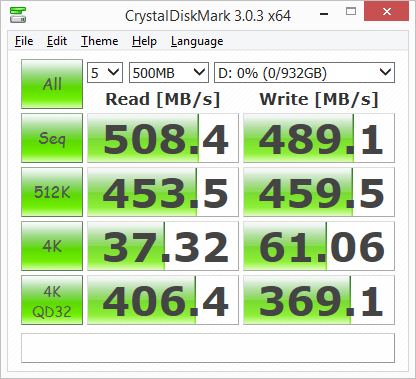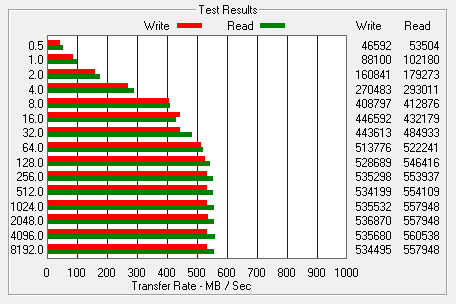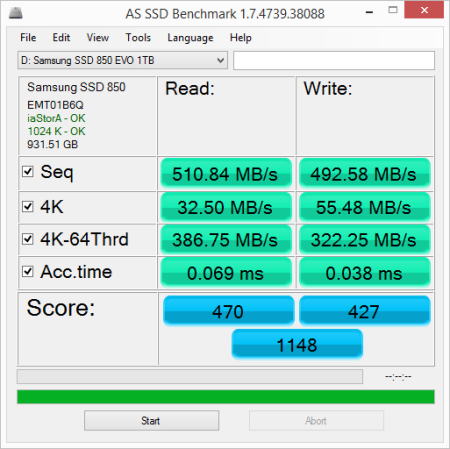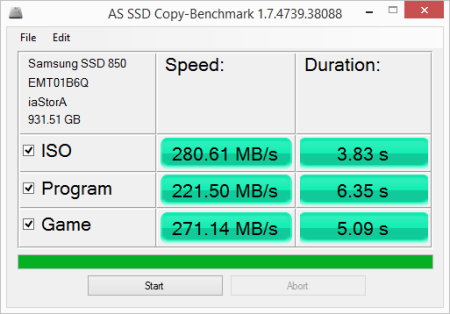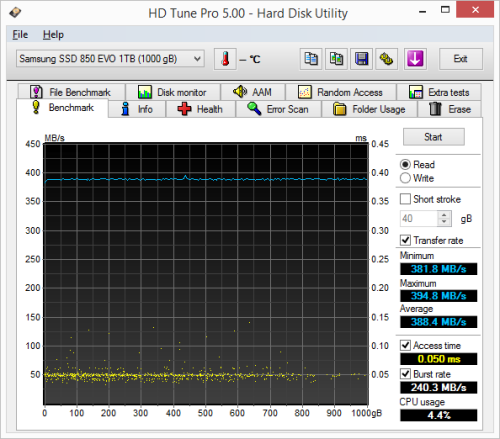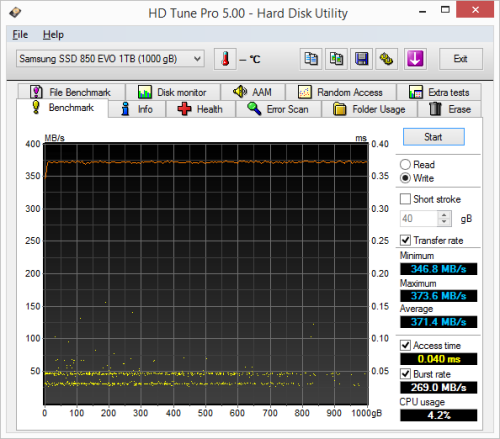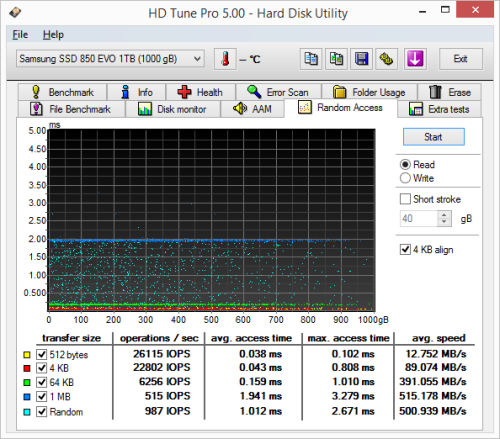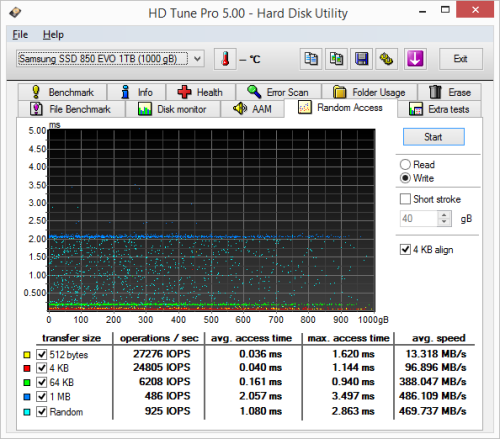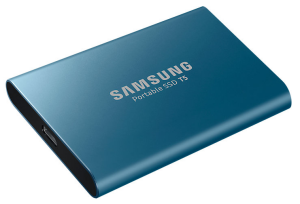
![]()
Model: Samsung T5 500GB Portable Solid State Drive
Manufacturer: Samsung Electronics
Provided By: Samsung America
Samsung Electronics has been a leader in the electronics industry for more than 30 years. Since the introduction of their first television in 1970, this Korean company has grown to become one of the world's leading electronics manufacturers, offering everything from tiny semiconductors to large home appliances. Samsung is no stranger to the storage industry either. Along with an assortment of DVD and Blu-ray Disc drives, the company offers both hard drive and flash based storage solutions for the portable and desktop computer markets.
This past fall, Samsung launched its latest portable solid state drive, the T5. Designed especially for content creators, business and IT professionals as well as mainstream consumers, this pocket-sized SSD is lightweight, yet durable. Thanks to a sturdy metal body and shock-resistant internal frame, the drive can withstand accidental drops of up to 2 meters. On the inside, the T5 is powered by Samsung's MGX controller and is available with up to 2TB of their 64-layer V-NAND flash. It is also equipped with a USB 3.1 Gen 2 interface which lets users transfer a 4.8GB 4K UHD movie in as little as 12 seconds. To top it all off, the T5 offers password protection of data with AES 256-bit hardware encryption.
The T5 is available in 250, 500GB, 1TB and 2TB capacities. For this review, Samsung sent us the 500GB version of the drive which is capable of delivering up to 540 MB/s sequential read and 515 MB/s sequential write speeds.
| Samsung T5 500GB Portable SSD | |||||||||||||||||||||||||||||||||
General Specifications
Performance
Environmental
Dimensions and Weight
Other Features
|
Needless to say, this is only a taste of what the T5 has to offer. To give you an idea of what to expect, we'll take a closer look at Samsung's latest portable SSD and then see how well it performs. Does the T5 have what it takes? Can it deliver the performance and features that we've come to expect from Samsung? Keep reading as we find out.
The T5 comes in a small white box. Along with a picture of the drive, the front advertises key features like its 500GB capacity and support for Windows, Mac and Android operating systems. The back of the box provides a bit more information regarding the T5's specifications, features and box contents. Inside, you'll find the SSD, a USB 3.1 Type-C to C cable, a USB 3.1 Type-C to A cable, a quick start guide and warranty statement.

Physical Features:
Like Samsung's previous portable SSDs, the T5 is very well constructed. The drive's outer casing is made out of aluminum and, depending on the capacity, has either a black or blue finish. Even for a portable drive, the T5 is also quite small. The drive measures 74 x 57.3 x 10.5 mm and tips the scales at a mere 51 grams.


The T5's USB 3.1 Gen 2 Type-C port is located on the end of the drive. This interface not only transfers data, but provides power for the device. It's hard to see in this picture, but the right of the USB port is a small LED that lights up blue or red to show when the T5 is idle, active and can be safely removed.

I wasn't able to crack the T5 open. However, if you were to do so, you'd find Samsung's own S4LN045X01-8030 controller. Developed entirely in house, this proprietary, triple-core MEX controller excels at multi-tasking. Based on an ARM Cortex R4 (400MHz) controller, its three CPU cores can execute multiple instructions such as reading data, writing data and optimization. The T5 also uses Samsung's new 64-layer V-NAND technology. The drive has two 250GB flash packages as well as a single 512MB LPDDR3 DRAM memory chip that is used for caching.
As I mentioned earlier, the T5 has the ability to password protect your data using AES 256-bit hardware encryption. This is done using Samsung's Portable SSD Software, which is available for Windows, Mac OS and Android. The Windows and Mac versions come with the drive and can be downloaded from Samsung's website. Otherwise, the Android version is available through the Google Play store.
Installing the Windows version is pretty straightforward and can be done with a few clicks of the mouse. When it's done, Samsung's Portable SSD Software will launch. From here, you can go into settings, enable the security mode and enter a password.

The next time you plug the T5 into your computer, Samsung's Portable SSD Software will automatically launch and prompt you for the password you entered. Once unlocked, you can use the software to check the used capacity, change your settings and, if need be, turn off the security mode.


Samsung's Portable SSD Software also creates a read only partition containing standalone versions of itself. This lets you plug the T5 into any computer running Windows or Mac OS, launch the software and unlock your data without making changes to the system.

The Android app works a lot like the Windows version of Samsung's Portable SSD Software. Once installed, the app will automatically launch whenever you plug the T5 into your device. From here you can enter your password and then access your data. The only thing that the Android app doesn't let you do is update the T5's firmware. If you want to do that, you will need to use the Windows or Mac OS version of the software.
I should point out that for maximum compatibility, you should use the exFat file system. The T5 comes formatted this way and is compatible with Windows, Mac OS and Android. If you decide to format the drive using NTFS or HFS, the drive may be read only or not recognizable at all on some platforms.
The test system used in this review was an HP 8200 Elite. The computer came equipped with an Intel Core i5-2400 CPU, 4GB of DDR3 1333MHz memory, Seagate Barracuda 7200.12 ST3250312AS 250GB SATA 6 Gb/s hard drive, NVIDIA Quadro FX580 512MB PCIe graphics card and an Intel 82579-LM gigabit network card. For the operating system, I installed a fresh copy of Windows 7 Enterprise.
To test the performance of Samsung's 500GB T5 SSD, I ran a series of benchmarks using CrystalDiskMark, HD Tach RW, ATTO Disk Benchmark, AS SSD, HD Tune Pro, Anvil's Storage Utilities, Iometer and PCMark 8. For comparison, I've also included test results from the Crucial MX500, Crucial BX300, ADATA Ultimate SU900, Plextor S3C, Toshiba OCZ VX500, ADATA Ultimate SU800, Plextor S2C, Crucial M300, Plextor M7V, PNY CS1311, OCZ Trion 150, PNY CS2211, Plextor M6V, Crucial BX200, OCZ Trion 100, Kingston HyperX Savage, Crucial MX200, OCZ Vector 180, Kingston BX100, Samsung 850 EVO M.2, Samsung 850 EVO mSATA, AMD Radeon R7, Silicon Power Slim S80, Samsung SSD 850 EVO, OCZ ARC 100, SanDisk Ultra II, Crucial MX100, SanDisk Extreme Pro and Samsung SSD 850 PRO.

As I mentioned earlier, the T5 is based on Samsung's MGX controller chip. Looking at the screenshot above, you can see that it performs equally well with both incompressible (0%) and compressible (100%) data.
CrystalDiskMark 5.1.2:
First, I ran a few quick tests using CrystalDiskMark. This benchmark tool measures the performance of a storage device by testing its sequential read and write speeds as well as its random read and write speeds using blocks 512K and 4K in size.
According to Samsung, the T5 is capable of reading at 540 MB/s and writing at 515 MB/s when connected to a USB 3.1 Gen 2 port. While the drive had no problems reaching its rated read speed, it came up a bit short in CrystalDiskMark's sequential write speed test.
The T5 can also be plugged into a USB 3.1 Gen 1 (USB 3.0) port. However, with half the bandwidth, its sequential read and write speeds aren't quite as fast.
HD Tach RW 3.0.4.0:
Next, I used HD Tach to test the T5's read, write and burst speeds as well as its seek times and CPU usage.

Samsung T5 500GB
Looking at the screenshot above, you can see that the T5 had average read and write speeds of 321.4 MB/s and 333.1 MB/s respectively, as well as a burst speed of 247.6 MB/s.
ATTO Disk Benchmark 2.46:
I also used ATTO Disk Benchmark to test the T5's sequential read and write speeds. The tests are run using blocks ranging in size from 0.5KB to 8192KB and the total length set to 256MB.
When tested with ATTO, the T5's read speeds topped out at about 560 MB/s and its write speeds at 527 MB/s.
AS SSD:
AS SSD is a benchmark designed specifically for solid state drives. The application contains five synthetic tests which are used to determine the sequential and random read and write performance of a drive.
AS SSD also includes a copy benchmark. This test copies an ISO (two large files), program (many small files) and game (small and large files), returning the speed and duration of each.
HD Tune Pro 5.00:
Next, I ran a series of tests using HD Tune Pro. This hard disk utility measures a drive's performance by testing its sequential read and write speeds as well as its access time, burst rate and CPU usage. For this review, I'm also going to use it to benchmark the T5's random read and write speeds, random access times and the number of operations per second.
The T5 performed relatively well when benchmarked with HD Tune. The drive had average read and write speeds of 447.5 MB/s and 424.6 MB/s, respectively, and a burst rate of 204.0 MB/s when reading.
The T5 didn't perform nearly as well as the 850 EVO when doing random reads and writes. When reading 4KB blocks, the drive reached 13,188 IOPS and had an average speed of 51.517 MB/s. The T5 was slightly faster when writing, reaching 13,207 IOPS with an average speed of 51.591 MB/s.
Anvil's Storage Utilities:
Anvil's Storage Utilities is another new benchmark designed with SSDs in mind. The standard storage benchmark measures a drive's performance by testing its transfer speeds, access times and IOPS.

Iometer:
Lastly, I ran a series of tests using Iometer. This tool can be configured to benchmark a number of things. In this case, I used it to measure the T5's read and write speeds and the number of operations per second. The tests were run using random bytes and a queue depth of 3.

The T5's performance was very similar to what we saw in our other tests. The drive was able to read at 529.20 MB/s and write at 502.97 MB/s.

The T5 wasn't one of the faster drives we've tested when it came to random reads and writes. In our tests, the drive was able to read at 115.08 MB/s and write at an impressive 128.63 MB/s.

Samsung really doesn't say what the T5 is capable of in regards to IOPS. In our tests, the drive reached 29,460 random read IOPS and 32,931 random write IOPS. Increasing the queue depth had little impact on the T5's random write performance. However, with the queue depth set to 32, the drive was able to reach 39,126 random read IOPS.
Vantage PCMark 8 - Storage Test:
PCMark 8 is a complete benchmark for Windows. It includes five benchmark tests, each designed around a specific scenario. The storage benchmark measures drive performance using real-world traces recorded from Adobe Creative Suite, Microsoft Office and a selection of popular games.

PCMark 8 also includes a consistency test which measures the performance consistency and degradation tendency of a storage system. The test reports the performance level at the start, the degraded steady-state and the recovered state as well as the number of iterations required to reach them. For this test, we are focusing on the Adobe Photoshop (Heavy) trace and will look at both the bandwidth and latency of the drive


The T5 did surprisingly well throughout PCMark's consistency test. While not as fast as the Crucial MX500, it performed better than the Crucial BX300 and Samsung 850 EVO throughout the degradation and steady state phases. The T5's performance also increased during the recovery phase, topping out at about 360 MB/s.
TRIM Performance:
While SSDs offer many benefits, there are some downsides to using flash memory. One of the biggest issues people run into is performance degradation. Over time, an SSD will run out of fresh blocks and will have to write over data the file system has marked as deleted. This procedure is very complicated and can slow an SSD's write speeds considerably.
To address this problem, most manufacturers have added TRIM support to their SSDs. The TRIM command allows an operating system, such as Windows 7, to tell an SSD which data blocks are no longer in use. Using this information, the drive pro-actively erases these blocks and adds them to the free block pool.

To test the T5's TRIM and garbage collection functions, I first put the drive in a "dirty" state. I used Iometer to fill the entire drive and then ran a random write test for 30 minutes. This had little impact on the T5's read speed. However, its average writing speed dropped to 84.3 MB/s.

Samsung T5 - Dirty
To see how well the T5 could recover, I let the computer sit for about 30 minutes and then reran the test. Looking at the screenshot below, you can see that the drive's average writing speed jumped back up to 311.2 MB/s.

Samsung T5 - After Trim
Lastly, I used Parted Magic to perform a secure erase of the T5. With the drive wiped clean, it had average read and write speeds of 321.8 MB/s and 315.7 MB/s, respectively.

Samsung T5 - Secure Erase
Final Thoughts:
Samsung's T5 portable SSD is a great addition to the company's already impressive line of flash-based storage products. Designed for professionals as well as mainstream consumers, this lightweight, pocket-sized drive not only looks great, but is also durable enough for day to day use. The T5 is also powered by the same 2-core MGX controller found in the 850 EVO and is available with up to 2TB of Samsung's latest 64-layer V-NAND flash. Combine this with a USB 3.1 Gen 2 interface and you have a portable SSD that's capable of some pretty impressive performance. In our sequential read and write tests, the T5 was able to read at speeds as high as 560 MB/s and write at speeds in excess of 502 MB/s. It also performed fairly well when doing random reads, but lagged behind many of the internal SSDs in our random write tests, producing less than 33,000 IOPS.
The Samsung T5 is available now in 250GB, 500GB, 1TB and 2TB capacities. Prices on Amazon.com currently range from $120 up to $740, with the 500GB version reviewed here retailing for about $160.

Highs:
- Available in 250GB, 500GB, 1TB and 2TB capacities
- Built with 64-layer V-NAND technology
- USB 3.1 Gen 2 interface
- Excellent sequential read and write speeds
- Compact and durable design with shock resistant internal frame
- Supports TRIM
- Password protection with AES 256-bit hardware encryption
- Includes Samsung's Portable SSD Software for Windows, Mac and Android
- Reasonably priced
- 3 year warranty
Lows:
- Lackluster random write performance






